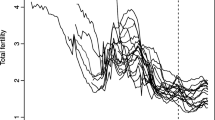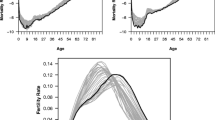Abstract
Accurate forecasts of age-specific fertility rates are critical for government policy, planning and decision making. With the availability of the Human Fertility Database (2011), the paper compares the empirical accuracy of the point and interval forecasts, obtained by the approach of Hyndman and Ullah (Comput Stat Data Anal 51(10), 4942–4956, 2007) and its variants for forecasting age-specific fertility rates. The analyses are carried out using the age-specific fertility data of 15 mostly developed countries. Based on the one-step-ahead to 20-step-ahead forecast error measures, the weighted Hyndman-Ullah method provides the most accurate point and interval forecasts for forecasting age-specific fertility rates, among all the methods we investigated.


Similar content being viewed by others
References
Abraham, B., & Ledolter, J. (1983). Statistical methods for forecasting. New York: Wiley.
Ahlburg, D. A. (1998). Using economic information and combining to improve forecast accuracy in demography. Working paper. Minneapolis: Industrial Relations Center, University of Minnesota.
Ahlburg, D. A. (2001). Population forecasting. In J. S. Armstrong (Ed.), Principles of forecasting (pp. 557–575). New York: Kluwer.
Akaike, H. (1974). A new look at the statistical model identification. IEEE Transactions on Automatic Control, 19(6), 716–723.
Alho, J. M. (1990). Stochastic methods in population forecasting. International Journal of Forecasting, 6(4), 521–530.
Alho, J. M. (1998). A stochastic forecast of the population of Finland, Reviews 1998/4. Helsinki: Statistics Finland.
Alho, J. M., & Spencer, B. D. (2005). Statistical demography and forecasting. New York: Springer.
Bates, J. M., & Granger, C. W. J. (1969). The combination of forecasts. Operations Research Society, 20(4), 451–468.
Bell, W. (1988). Applying time series models in forecasting age-specific fertility rates. Working paper. New York: Bureau of the Census.
Bell, W. (1992). ARIMA and principal components models in forecasting age-specific fertility. In N. Keilman & H. Cruijsen (Eds.), National population forecasting in industrialized countries (pp. 177–200). Amsterdam: Swets & Zeitlinger.
Bell, W. (1997). Comparing and assessing time series methods for forecasting age-specific fertility and mortality rates. Journal of Official Statistics, 13(3), 279–303.
Bongaarts, J. & Sobotka, T. (2011). Demographic explanation for the recent rise in European fertility: Analysis based on the tempo and parity-adjusted total fertility. Working paper. New York: Population Council.
Booth, H., Hyndman, R. J., Tickle, L., & De Jong, P. (2006). Lee-Carter mortality forecasting: A multi-country comparison of variants and extensions. Demographic Research, 15, 289–310.
Box, G. E. P., Jenkins, G. M., & Reinsel, G. C. (2008). Time series analysis: Forecasting and control (4th ed.). Hoboken: Wiley.
Bozik, J. & Bell, W. (1987). Forecasting age specific fertility using principal components (pp. 396–401). In Proceedings of the American Statistical Association. Social Statistics Section, San Francisco.
Bozik, J. E. & Bell, W. R. (1989). Time series modelling for the principal components approach to forecasting age specific fertility. SRD Research Report. Washington, DC.: Statistical Research Division, Bureau of the Census.
Carter, L. R., & Lee, R. D. (1986). Joint forecasts of U.S. marital fertility, nuptiality, births and marriages using time series models. Journal of the American Statistical Association, 81(396), 902–911.
Conway, J. B. (1994). A course in functional analysis (2nd ed.). New York: Springer.
de Beer, J. (1985). A time series model for cohort data. Journal of the American Statistical Association, 80(391), 525–530.
Dowd, K., Cairns, A. J. G., Blake, D., Coughlan, G. D., Epstein, D., & Khalaf-Allah, M. (2010). Evaluating the goodness of fit of stochastic mortality model. Insurance Mathematics and Economics, 47(3), 255–265.
Eubank, R. L. (1999). Nonparametric regression and spline smoothing (2nd ed.). New York: Marcel Dekker.
Goldstein, J. R. & Cassidy, T. (2010). Cohort postponement and period measures. Working paper No.15. Rostock: Max Planck Institute for Demographic Research.
He, X., & Ng, P. (1999). COBS: Qualitatively constrained smoothing via linear programming. Computational Statistics, 14(3), 315–337.
Human Fertility Database (2011). Max Planck Institute for Demographic Research (Germany) and Vienna Institute of Demography (Austria). Available at www.humanfertility.org. Data downloaded on Nov 16, 2011.
Hyndman, R. J. (2011a). Demography: Forecasting mortality, fertility, migration and population data. R package version 1.11. http://CRAN.R-project.org/package=demography.
Hyndman, R. J. (2011b). Forecast: Forecasting functions for time series. R package version 3.18. http://CRAN.R-project.org/package=forecast.
Hyndman, R. J., & Booth, H. (2008). Stochastic population forecasts using functional data models for mortality, fertility and migration. International Journal of Forecasting, 24(3), 323–342.
Hyndman, R. J. & Khandakar, Y. (2008). Automatic time series forecasting: the forecast package for R. Journal of Statistical Software 27(3).
Hyndman, R. J., Koehler, A. B., Ord, J. K., & Snyder, R. D. (2008). Forecasting with exponential smoothing: The state space approach. Berlin: Springer.
Hyndman, R. J., & Shang, H. L. (2009). Forecasting functional time series (with discussion). Journal of the Korean Statistical Society, 38(3), 199–221.
Hyndman, R. J., & Ullah, M. S. (2007). Robust forecasting of mortality and fertility rates: A functional data approach. Computational Statistics & Data Analysis, 51(10), 4942–4956.
Iqbal, M. A., & Hoque, M. A. (2008). Robust forecasting of fertility trends in Bangladesh. Middle East Journal of Age and Ageing, 5(1), 13–22.
Keilman, N., & Pham, D. Q. (2000). Predictive intervals for age-specific fertility. European Journal of Population, 16(1), 41–66.
Land, K. C., & Cantor, D. (1983). ARIMA models of seasonal variation in U.S. birth and death rates. Demography, 20(4), 541–568.
Lazar, D., & Denuit, M. M. (2009). A multivariate time series approach to projected life tables. Applied Stochastic Models in Business and Industry, 25(6), 806–823.
Lee, R. D. (1974). Forecasting births in post-transitional populations: Stochastic renewal with serial correlated fertility. Journal of the American Statistical Association, 69(347), 607–617.
Lee, R. D. (1975). Natural fertility, population cycles and the spectral analysis of births and marriages. Journal of the American Statistical Association, 70(350), 295–304.
Lee, R. D., & Carter, L. R. (1992). Modeling and forecasting U.S. mortality. Journal of the American Statistical Association, 87(419), 659–671.
Lee, R., & Tuljapurkar, S. (1994). Stochastic population forecasts for the United States: Beyond high, medium and low. Journal of the American Statistical Association, 89(428), 1175–1189.
Liu, Y., Gerland, P., Spoorenberg, T., Vladimira, K. & Andreev, K. (2011). Graduation methods to derive age-specific fertility rates from abridged data: A comparison of 10 methods using HFD data. Working Paper. New York: Columbia University.
Lutz, W., & Scherbov, S. (1998). An expert-based framework for probabilistic national population projections: The example of Austria. European Journal of Population, 14(1), 1–17.
McDonald, J. (1979). A time series approach to forecasting Australian total live births. Demography, 16(4), 575–602.
McDonald, J. (1981). Modeling demographic relationships: An analysis of forecast functions for Australian births. Journal of the American Statistical Association, 76(376), 782–792.
Miller, R. B. & Hickman, J. C. (1981). Time series modelling of births and birth rates. Working paper 8-81-21. Graduate School of Business, University of Wisconsin-Madison.
Miller, R. B. & McKenzie, S. K. (1984). Time series modelling of monthly general fertility rates. SRD Research Report 84/16. Washington, DC.: Statistical Research Division, Bureau of the Census.
Nelder, J. A., & Mead, R. (1965). A simplex method for function minimization. Computer Journal, 7(4), 308–313.
Peristeva, P., & Kostaki, A. (2005). An evaluation of the performance of kernel estimators for graduating mortality data. Journal of Population Research, 22(2), 185–197.
R Development Core Team. (2011). R: A language and environment for statistical computing. Vienna: R Foundation for Statistical Computing. URL: http://www.R-project.org/.
Ramsay, J. O. (1988). Monotone regression splines in action. Statistical Science, 3(4), 425–441.
Ramsay, J. O., & Silverman, B. W. (2005). Functional data analysis (2nd ed.). New York: Springer.
Rogers, A. (1986). Parameterized multistate population dynamics and projections. Journal of the American Statistical Association, 81(393), 48–61.
Rueda-Sabater, C., & Alvarez-Esteban, P. C. (2008). The analysis of age-specific fertility patterns via logistic models. Journal of Applied Statistics, 35(9), 1053–1070.
Saboia, J. L. M. (1977). Autoregressive integrated moving average (ARIMA) models for birth forecasting. Journal of the American Statistical Association, 72(358), 264–270.
Sanderson, W. C. (1998). Knowledge can improve forecasts? A review of selected socioeconomic population projection models. Population and Development Review, 24(supplement), 88–117.
Shang, H. L., Booth, H., & Hyndman, R. J. (2011). Point and interval forecasts of mortality rates and life expectancy: A comparison of ten principal component methods. Demographic Research, 25(5), 173–214.
Smith, S. K., & Shahidullah, M. (1995). An evaluation of population projection errors for census tracts. Journal of the American Statistical Association, 90(429), 63–71.
Smith, S. K., & Sincich, T. (1991). An empirical analysis of the effect of length of forecast horizon on population forecast errors. Demography, 28(2), 261–274.
Swanson, D. A., & Beck, D. M. (1994). A new short-term county population projection method. Journal of Economic and Social Measurement, 20(1), 25–50.
Tayman, J., Smith, S. K., & Lin, J. (2007). Precision, bias, and uncertainty for state population forecasts: An exploratory analysis of time series models. Population Research and Policy Review, 26(3), 347–369.
Thompson, P. A., Bell, W. R., Long, J. F., & Miller, R. B. (1989). Multivariate time series projections of parameterized age-specific fertility rates. Journal of the American Statistical Association, 84(407), 689–699.
Yang, S. S., Yue, J. C., & Huang, H.-C. (2010). Modeling longevity risks using a principal component approach: A comparison with existing stochastic mortality models. Insurance Mathematics and Economics, 46(1), 254–270.
Acknowledgments
The author would like to thank the editor-in-chief, the associate editor, and two referees for their insightful comments, which led to a much improved version of the manuscript. The author thanks Professors Heather Booth and Rob Hyndman for introducing him to the field of demographic forecasting.
Author information
Authors and Affiliations
Corresponding author
Rights and permissions
About this article
Cite this article
Shang, H.L. Point and interval forecasts of age-specific fertility rates: a comparison of functional principal component methods. J Pop Research 29, 249–267 (2012). https://doi.org/10.1007/s12546-012-9087-4
Published:
Issue Date:
DOI: https://doi.org/10.1007/s12546-012-9087-4




